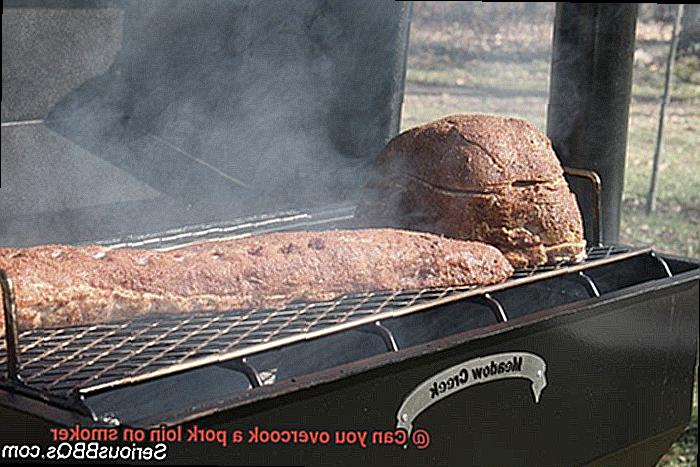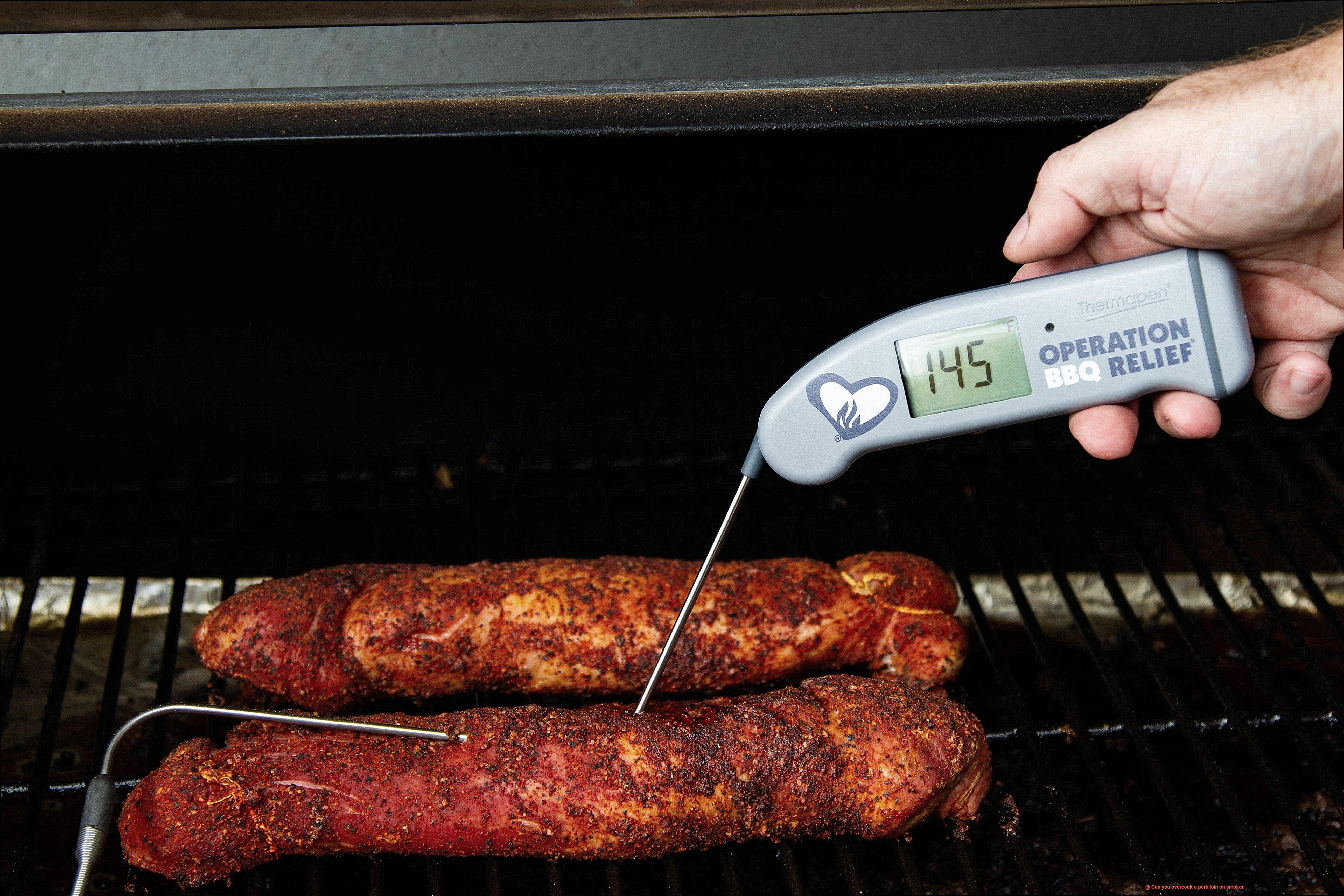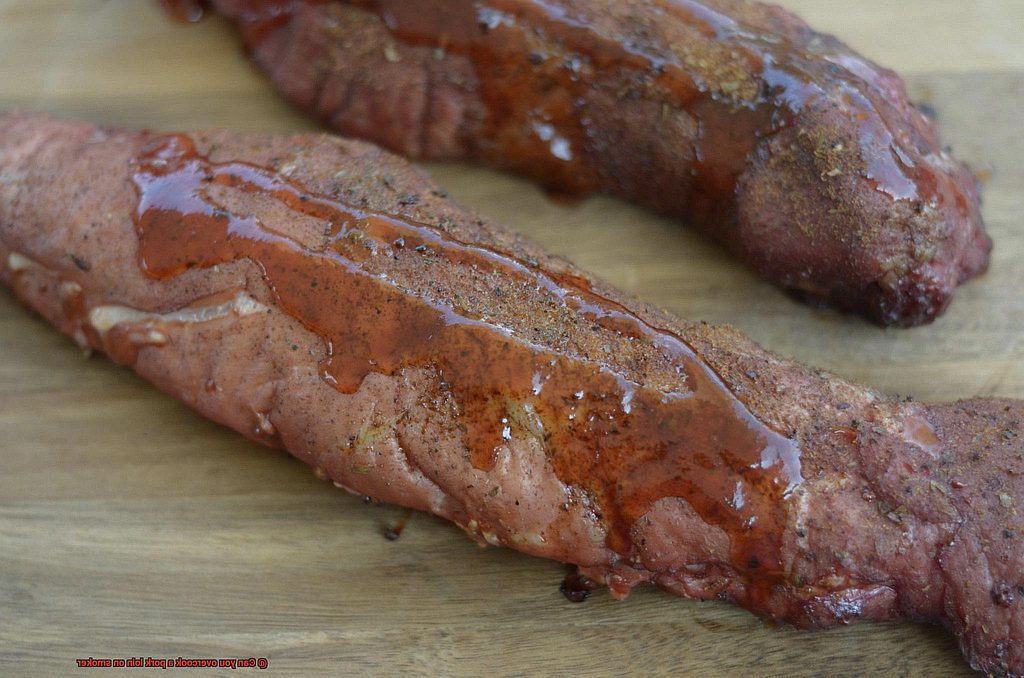You’ve fired up your smoker and decided to tackle a pork loin. It’s all about finding that sweet spot between juicy and flavorful, right?
But what happens when you accidentally take it too far and end up with a dry and tough piece of meat? Can you actually overcook a pork loin on the smoker?
Well, my friend, in this blog post we’re going to dig deep into the world of smoking pork loins. We’ll explore the consequences of overcooking and share some insider tips to ensure your pork loin always comes out tender and mouthwatering.
So, grab your aprons and let’s dive into the smoky goodness together.
Contents
What is a Pork Loin?
A pork loin is a cut of meat that comes from the back of a pig, specifically between the shoulder and the leg. It is highly regarded for its tenderness and flavor, making it a popular choice for many recipes. The pork loin is known for its lean nature, with minimal fat marbling throughout the meat. This makes it a healthier option compared to other cuts of pork.
Pork loins can vary in size, but they are typically long and cylindrical in shape. They are often sold as a whole piece, but can also be found pre-cut into chops or smaller portions. It’s worth noting that pork loins can be bone-in or boneless. Some people prefer bone-in cuts as they believe it adds more flavor during cooking, while others find boneless cuts easier to handle and slice.
Cooking a pork loin requires careful attention to temperature and time. It can be prepared using various methods such as roasting, grilling, or smoking. Seasoning with rubs or marinades before cooking can enhance the flavor of the meat. The cooking time and temperature will depend on the desired level of doneness and the method being used.
To ensure that a pork loin is cooked to perfection, it is recommended to use a meat thermometer to monitor the internal temperature. The ideal internal temperature for a fully cooked pork loin is around 145°F (63°C). Going beyond this temperature can result in a dry and tough texture. It is also important to allow the cooked pork loin to rest before slicing, as this allows the juices to redistribute throughout the meat, resulting in a more flavorful and moist end result.
Why Use a Smoker for Cooking Pork Loin?
Imagine the scene: a lazy summer afternoon, the air thick with the intoxicating aroma of smoldering wood chips, and the anticipation of sinking your teeth into a succulent and smoky pork loin. Is your mouth watering yet? If not, it surely will be as we explore the myriad reasons why employing a smoker for cooking pork loin is an absolute game-changer.
First and foremost, a smoker is no ordinary cooking device; it is a specialized tool that brings out the very best in your pork loin. Its low and consistent heat ensures that every inch of meat is cooked evenly, resulting in a tender and juicy masterpiece. No more dry and flavorless pork loin for you.
But it’s not just about even cooking. The real magic lies in the introduction of smoke to the equation. Whether you choose hickory, mesquite, or applewood, each type of wood chip or pellet adds its own unique flavor to your pork loin. The choice is yours to tailor your culinary creation to perfection.
Moreover, using a smoker guarantees moisture retention. The slow cooking process prevents the meat from drying out, resulting in a melt-in-your-mouth texture that will leave your taste buds begging for more. And let’s not forget the endless possibilities for seasoning and flavoring your pork loin before smoking. From tangy marinades to aromatic rubs, you have the power to create an unforgettable dish.
What truly sets using a smoker apart is the opportunity for experimentation and creativity. Why settle for ordinary when you can create extraordinary? Combine different types of wood chips or pellets to achieve unique flavors. Play around with seasoning blends or brines to elevate your pork loin to new heights. The only limit is your imagination.
How to Prevent Overcooking Pork Loin on the Smoker
Pork loin is a delicious cut of meat that can be cooked to perfection on a smoker. But beware, overcooking it can turn this succulent cut of meat into a dry and tough disappointment. To ensure that your pork loin comes out juicy and tender every time, follow these simple steps:
The Ideal Internal Temperature
The key to preventing overcooked pork loin is to cook it to the right internal temperature. The National Pork Board recommends an internal temperature of 145°F (63°C) for fully cooked pork loin. This temperature ensures that the meat is safe to eat while still retaining its juiciness.
To determine the internal temperature accurately, use a reliable meat thermometer. Insert the thermometer into the thickest part of the pork loin, avoiding contact with bone or fat. Take multiple readings from different spots to ensure accuracy.
Regulate the Smoker’s Temperature
Maintaining a consistent and appropriate temperature in your smoker is crucial. Preheat the smoker before adding the pork loin and adjust the vents or dampers to control airflow. This will help you achieve the desired cooking temperature.
Monitor the temperature throughout the cooking process to prevent overheating. If necessary, adjust the vents or add more fuel to maintain a steady temperature.
Positioning and Indirect Heat
Direct heat can cause uneven cooking and increase the risk of overcooking. Position the pork loin away from direct heat sources in your smoker.
Instead, use a two-zone cooking setup by creating a hotter direct heat zone and a cooler indirect heat zone. Start by searing the pork loin over direct heat to develop a nice crust, then move it to the indirect heat zone to finish cooking slowly and evenly.
Brine or Marinate
Before smoking, consider brining or marinating your pork loin. This helps add moisture and flavor to the meat, making it less prone to drying out during the cooking process.
For a simple brine, combine water, salt, sugar, and your choice of herbs and spices. Let the pork loin soak in the brine for at least 4 hours or overnight before smoking. Alternatively, marinate the pork loin in your favorite marinade for a few hours prior to smoking.
Resting
After removing the pork loin from the smoker, let it rest for at least 10-15 minutes before slicing or serving. This allows the meat to reabsorb its juices and finish cooking internally without the heat source.
During this resting period, cover the pork loin loosely with foil or place it in a warm oven to keep it warm. The resting time ensures a moist and flavorful end result.
What is the Ideal Internal Temperature for Fully Cooked Pork Loin?
Look no further than a mouthwatering, perfectly smoked pork loin. This showstopping cut of meat can steal the spotlight at any backyard barbecue or family gathering. But what’s the secret behind achieving that juicy and tender pork loin? It all comes down to mastering the ideal internal temperature. In this article, we’ll delve into the recommended temperature, cooking techniques, and expert tips to ensure your pork loin is an irresistible success.
The Ideal Internal Temperature:
To achieve a fully cooked and safe-to-eat pork loin, the United States Department of Agriculture (USDA) recommends an internal temperature of 145°F (63°C). This temperature strikes the perfect balance between food safety and preserving the juiciness and tenderness of the meat. It’s important to note that this guideline applies specifically to pork loins cooked whole, without any stuffing or added ingredients.
Measuring the Temperature:
To accurately measure the internal temperature of your pork loin, invest in a reliable meat thermometer. Insert it into the thickest part of the meat, ensuring it doesn’t touch any bones or fat. This guarantees an accurate reading and prevents undercooking or overcooking.
Smoking Techniques:
Consistency is key when smoking a pork loin. Maintain a smoker temperature between 225°F (107°C) and 250°F (121°C) to achieve that perfect balance of smoky flavor and succulent texture. Remember, slow and steady wins the race when it comes to smoking. Allow approximately 20 minutes of cooking time per pound of pork loin, but always rely on the internal temperature for determining doneness.

Resting Period:
Once your pork loin reaches that ideal internal temperature of 145°F (63°C), resist the temptation to dive right in. Instead, let it rest for about 10 minutes before slicing. This resting period allows the juices to redistribute within the meat, resulting in a more flavorful and tender final product.
Catering to Preferences:
If you prefer your pork loin more well-done or have specific dietary restrictions to consider, you can cook it to a higher internal temperature. However, always ensure that the meat reaches a minimum internal temperature of 145°F (63°C) for food safety purposes.
What Factors Affect the Cooking Time of a Pork Loin on the Smoker?
Get ready to elevate your grilling game as we explore the factors that affect the cooking time of this delectable cut of meat on the smoker. Prepare to become a master of smoke and flavor.
First and foremost, the size and thickness of your pork loin are crucial factors in determining cooking time. A larger and thicker loin will naturally require more time on the smoker. So, take a moment to assess the weight and dimensions of your meat before embarking on your smoking journey.

Now, let’s talk temperature, my friends. Low and slow is the mantra when it comes to smoking pork loin. Aim for a smoker temperature between 225°F and 250°F for that juicy, fall-off-the-bone goodness. Anything higher than that might speed up cooking, but it risks drying out your precious meat. And we don’t want that, do we?
Let’s dive deeper into the heart of the matter – internal temperature. The magic number for a perfectly cooked pork loin is around 145°F. To ensure you hit that sweet spot, invest in a quality meat thermometer and keep a watchful eye on it throughout the cooking process. Remember, different smokers can have variations in heat distribution, so check that temperature for safe and mouthwatering results.
But don’t rush to slice into your masterpiece just yet. Allow your pork loin to rest for about 10 to 20 minutes before indulging. This resting time allows the juices to redistribute within the meat, resulting in an explosion of flavor and tenderness with every bite.
Ah, but the elements themselves can also influence your cooking time. Wind and ambient temperature have their say in this culinary dance. Wind can play tricks with heat distribution, while colder temperatures may require a tad more patience. So, be aware of your smoking environment and make adjustments accordingly.
And let’s not forget about the star of the show – the quality of your meat. Opt for fresh, high-quality pork loin for even cooking and less time on the smoker. Don’t skimp on quality, my friends. It makes all the difference in the world.
Now that you’re armed with these factors, it’s time to ignite the smoker and embark on a pork loin adventure like no other. Remember, cooking times can vary depending on personal preferences, equipment, and other variables. So, always keep that trusty meat thermometer handy for accurate monitoring.
Resting After Removal from the Smoker
Picture this: You’ve just taken your succulent, smoky pork loin off the grill. The air is thick with the mouthwatering aroma that can only come from hours of slow cooking over smoldering hardwood. But before you sink your teeth into that tantalizing meat, there’s one vital step you simply cannot skip – resting.
Resting is like a luxurious getaway for your pork loin. It’s a time for the juices to mingle and dance, the flavors to meld and harmonize, resulting in a bite that is nothing short of divine. Think of it as a chance for your meat to kick back and soak up all that smoky goodness, creating a symphony of taste in every mouthful.
During this period of repose, something magical happens. The internal temperature of the pork loin continues to rise ever so slightly, enhancing the tenderness and juiciness. This is precisely why it’s crucial not to overcook your meat on the smoker. The fear of dry and tough meat is enough to make any griller break out in a cold sweat.
But fear not. By granting your pork loin a well-deserved rest for about 10-15 minutes, you will be rewarded with slices that are juicy, tender, and bursting with flavor. This resting period also acts as a safeguard, ensuring that the precious moisture stays locked within the meat, preventing any loss of succulence.
Now that you understand the magnitude of resting, let me share some tips on how to give your pork loin the pampering it deserves:
- Tent it: As soon as you remove the pork loin from the smoker, gently drape it with a loose cover of aluminum foil. This makeshift tent will keep the meat warm and snug while preventing an excessive amount of heat from escaping.
- Give it space: Resisting the urge to carve into your pork loin immediately is a challenge, but one that pays off immensely. Instead, let it rest undisturbed on a cutting board, allowing the air to circulate freely around the meat. This will facilitate an even cooling process, ensuring that every slice is perfection personified.
- Time your dance: Resting time is a golden opportunity to attend to any final preparations – perhaps whipping up a delectable side dish or setting the table for a feast. So be sure to factor in this invaluable downtime when planning your grilling schedule. Your patience will be handsomely rewarded.
Techniques to Salvage an Overcooked Pork Loin
We’ve all been there – lost in the rhythm of the backyard barbecue, only to realize that our pork loin is now dry and tough from overcooking. But fret not, my friends. I’m here to share some expert techniques that will salvage that overcooked pork loin and transform it into a mouthwatering meal.
First and foremost, let’s harness the power of marinades and sauces. Create a simple marinade using a combination of olive oil, vinegar, soy sauce, and spices. Allow the overcooked pork loin to bathe in this flavorful concoction for several hours or even overnight. The magic of the marinade will work its wonders, rehydrating the meat and infusing it with a burst of taste. In a pinch for time? No worries. While the meat is still hot off the grill, generously brush on a delectable sauce. This will not only add moisture but also enhance the overall flavor profile.
If you’re a fan of thinly sliced meat, then this technique is tailor-made for you. Slice the overcooked pork loin into thin, delicate pieces to help break down its tough texture. With each bite, you’ll savor the pork loin’s flavors without being overwhelmed by its dryness.
But what if slicing isn’t enough? Fear not, for we have another trick up our sleeves – shredding. Utilize two forks to delicately pull apart the meat into smaller, more manageable strands. If time is not on your side, a few pulses in a food processor will do the trick. Once shredded, you can incorporate this succulent goodness into an array of dishes such as tacos, sandwiches, or salads.
Now let’s discuss how to reintroduce moisture into our overcooked pork loin. Reheat the slices or shreds in a pan with some broth or barbecue sauce, gently allowing them to soak in all that glorious liquid. This process will breathe new life into the meat, restoring its juiciness and making it a delight to devour.
Lastly, don’t hesitate to use the overcooked pork loin in recipes where its dryness can be masked. Think stir-fries or soups, where the addition of other ingredients and flavors can help balance out the texture. By combining the overcooked pork loin with complementary components, you’ll create a dish that is still utterly delicious despite the initial mishap.
dmCXIDfY1Z0″ >
Conclusion
In conclusion, it is absolutely possible to go overboard and overcook a pork loin on a smoker. And let me tell you, the end result is not pretty. We’re talking dry, tough, and far from the juicy and flavorful masterpiece we all dream of sinking our teeth into. But fear not. With a little finesse and some know-how, you can ensure that your pork loin comes out tender, succulent, and mouthwatering every single time.
The secret to avoiding this tragic fate lies in hitting that perfect internal temperature. You want your pork loin to reach a nice and cozy 145°F (63°C) internally for full doneness. To make sure you’re on point, invest in a reliable meat thermometer – your best friend in the quest for perfectly cooked pork.
But wait, there’s more. Temperature regulation is key when it comes to smoking like a pro. Keep that smoker humming at a consistent range between 225°F (107°C) and 250°F (121°C). This sweet spot will give you even cooking without sucking the life out of your precious pork.
Now let’s talk about positioning. No, not yoga poses – we’re talking about where you place that glorious hunk of meat in your smoker. Keep it away from direct heat sources and opt for indirect heat instead. This slow-and-steady approach ensures an even cook throughout, resulting in tender perfection.
Brining or marinating your pork loin before it hits the smoker can be a game-changer too. Not only does it add moisture like nobody’s business, but it also infuses incredible flavors into every fiber of that meaty goodness.
And here’s a pro tip: patience is everything. After removing your masterpiece from the smoker, resist the urge to dive right in with your carving knife. Let that baby rest for at least 10-15 minutes before slicing into it. This allows those precious juices to redistribute, ensuring a final product that is bursting with flavor and moist to the last bite.






